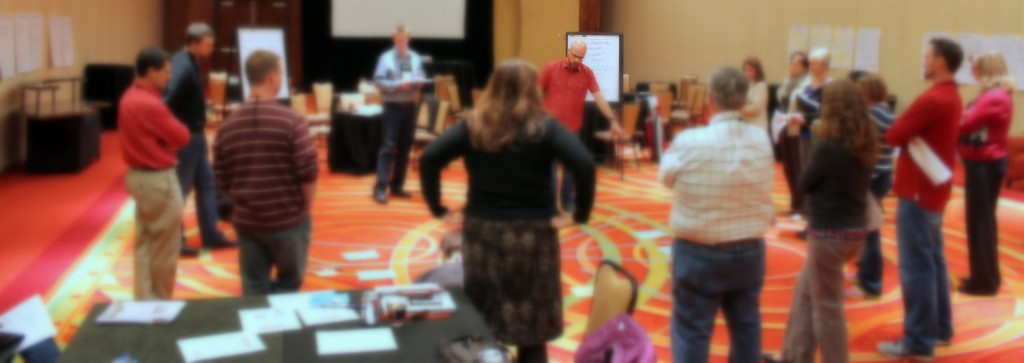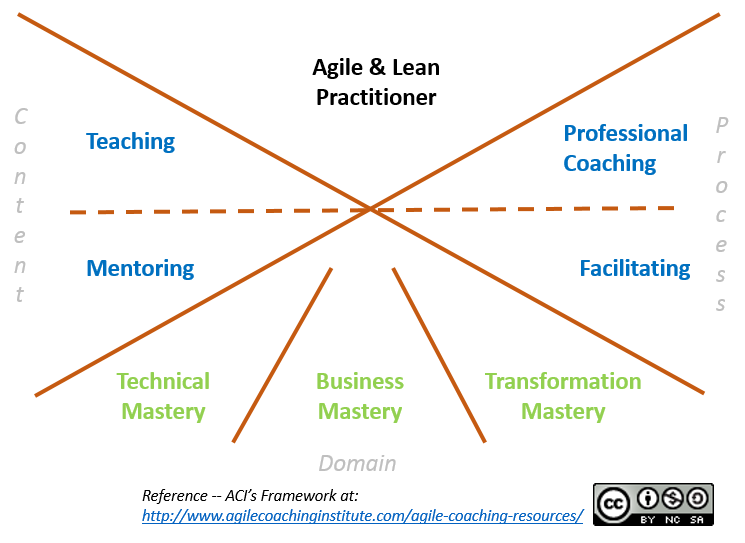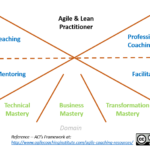There are many ways to look at the Agile Coach Competency Framework and many opportunities to learn. In Understanding ACI’s Agile Coach Competency Framework (Part 1), I outlined my summary of the framework, it’s competencies and the coaching stance. Part 2 looks at what you can learn from the framework and ideas about how to use the ideas to learn and grow as a coach and a leader.
Learning From the Agile Coach Competency Framework
I want to help people create a balance between the left of teaching and mentoring to the right of professional coaching and facilitation (or vice versa!). I think any agile coach should. Over time, people, teams, and organizations should be more and more comfortable with being coached from the professional coaching and facilitating spaces. I would never expect everything to come from just those two spaces, but we don’t have the option to stay just in the left spaces (teaching and mentoring) if the organization desires to move beyond “okay agile” to good or great. Organizations that continue to require you as an agile coach to constantly teach them about the same issue will limit their growth opportunities and their ability to excel on their own.
Elaborating on that last point, for each new coaching topic, teaching or mentoring may make sense, however if this is the 5th time that you want me to train you on definition of done, expect me to change the approach. I might ask:”Given definition of done has not been adopted a number of times already, I’m wondering if it is really valuable to you as an organization?” I would not be saying this as a game. I would say it because if I am coming from professional coaching, I truly believe you are intelligent and creative and that you are not playing a game. I am curious to understand what you see happening and not in judging you. I do not consider this to be easy, at least it is not always easy for me.
Maybe from professional coaching, they find the answer they need. Maybe I have to move to another space and try something else.
I mentioned that I have a bias for the professional coaching space. Everyone has a bias. Understanding what yours is can be quite valuable. Understanding where you might go when you are stressed is important as well. Perhaps you are extremely technical, you are facilitating a retrospective, and things get “tough.” You may revert to mentoring. Having an awareness of your bias is one way of giving yourself a choice in deciding to move to another coaching approach.
Remember that every agile coach needs to move through different process and content competencies to be effective!

You may start from teaching and realize that mentoring is more appropriate. I was recently coaching a client and was coming from facilitation. I was thinking that professional coaching was likely the next place to move, that they were ready to explore more and take on more challenges. I asked a few questions from that space. I was met with a direct request to help them from teaching. Sometime the client will ask you to shift (directly or indirectly) and sometimes you have to shift and sometimes you have to hold your ground to see what is really available!
Using the Coach Competency Framework
There are a likely hundreds of ways to use the Agile Coach Competency Framework. Here are a few ways to start.
Write down 3-5 coaching situations you have dealt with or are dealing with now. You just need a sentence for each, not a detailed description — and yes REALLY write them down.
- How have you tried to handle the situation? Does that approach fit into one of the process or content competencies? Can you identify a preference of one that feels right?
- Think of a challenge you have in your coaching world today (as a coach, manager, project manager, leader (everyone should be a leader), team member). Look at each competency, placing your finger in each one, and consider how you might address the problem from each place. What have you tried so far? What has worked for you in the past?
- Based on either of the first two, can you identify patterns when you use certain approaches that work or patterns where the approaches do not?
- For frustrating coaching situations: Are you coming from a competency that is not working for the client (person, team, organization, etc.)? Are you staying in that space too long? What is causing you to stay or stopping you from moving?
- Looking only at the domain competencies, place a red dot where you were 10 years ago, a yellow dot where you were 5 years ago, a green dot where you are today and a blue dot where you want to be in the future (don’t put the dots on your screen!). Remember there is NOT a right answer. How does that inform what you are doing today? How does that align with your learning goals for the next 12 months? What do the dots tell you about your satisfaction in your current position? They may cause you to realize any number of ideas that you might want to explore.
- Experiencing the Framework: In person, I use an experiential exercise based on one I learned from ACI to allow people to experience (not just talk about) each competency. This exercise incorporates a number of learning topics such as the ones I mention above. As I mentioned earlier, I have facilitated and coached teams at organizations as well as in public presentations of the framework many times and find people enjoy digging deeper into these ideas. There are two elements that are important to facilitating it. The first is understanding it. There are the basics and then the depth of the framework that takes time to sink into. There are always new insights however, so assuming you just “get it all” means you are missing something! Most of the insights I take away from the experiential exercise on the framework is not something that someone was teaching me (this is typically how experiential exercises are designed – and why I really like them). The framework is built in such a way that when you truly experience what it is like to be in each of the competencies it is a changing experience.
 Beyond a deep knowledge of it, in order to run an experiential session, there is the process of facilitating and coaching people through the exercise. If you are interested in experiencing it, I’d ask around to your local agile groups to see if they have someone who can facilitate a session on it or attend a class that covers this. If you can’t find anyone to run a session for you, let me know and I see what I can do to help you locate someone.
Beyond a deep knowledge of it, in order to run an experiential session, there is the process of facilitating and coaching people through the exercise. If you are interested in experiencing it, I’d ask around to your local agile groups to see if they have someone who can facilitate a session on it or attend a class that covers this. If you can’t find anyone to run a session for you, let me know and I see what I can do to help you locate someone.
Learn and Improve
Start by looking at how you tackle the agile coaching challenges you run into. Are you effective? Are you satisfied with your approach and the spaces you coach from? Are others? What can you change in your approach to improve? Where is your bias? I am always finding places where I can learn and improve. Over time I have identified a number of patterns that I experience with different types of clients.
I mentioned that the coach is ideally at choice on which process or content competency to use with a client (based on the clients needs of course). I say ideally because if you do not understand your background and bias, you may use one that is not serving you well in your service to the client. You may also be influenced by the client, your peers, or your boss! Be aware of where you are and where YOU want to be! (see Thoughts on Agile Coaching for more on that). Explain to others at the organization where you prefer to come from. Ask them to challenge you if they feel you are stuck in once place too long! I do that with many clients. It is a great way to introduce them to the Framework and give them a clear way to challenge you (which I personally like to hear).
My hope is that provides enough ideas to help you understand, explore, learn from, and build on ACI’s Agile Coach Competency Model. However… if not, please comment or contact me. I’d love to hear your take on it as well as issues or concerns you have (for an upcoming article), etc.








